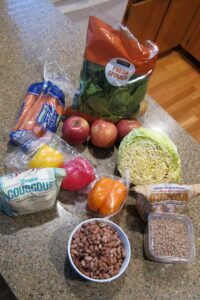All plants produce carbohydrates – sugar and starch. Through cooking, chewing, and enzymatic action during digestion, these substances transform into glucose molecules that the body uses for energy. When consumed in their whole, unrefined states, carbohydrate-rich foods contribute life-sustaining vitamins, minerals, enzymes, protein, fat, and fiber. They also moderate the speed at which glucose enters the bloodstream.
Like any finely tuned machine, our bodies want a steady supply of fuel to function at peak efficiency. They don’t want to be inundated with more than they can handle any more than they want to run dry. When we eat sugars and starches in their natural states alongside healthy protein and fat, they’re digested slowly, and the resulting sugars enter the bloodstream at a measured pace over a period of hours. The body gets exactly what it needs, when it needs it.
When we eat processed foods, sugars enter the bloodstream in a rush. The body kicks insulin and related hormone production into high gear to get rid of the excess. Excess insulin may work a little too well, plunging blood sugar lower than its desired state. The resulting hunger pangs may trigger further consumption of processed foods, which starts that negative spiral all over again. Eventually, the body stops responding to insulin and accumulates an unhealthy level of sugar in the bloodstream, a condition known as diabetes. And because processed foods lack the vitamins, minerals, fiber, et al associated with whole foods, the body must deplete its nutrient reserves to sustain life and/or suffer the ill effects of nutrient deficiencies.
We exacerbate our processed foods sugar rush with direct consumption of sugars and syrups. Sugar used to be a luxury item whose delights were experienced sparingly. In 1700, inhabitants of the developed world consumed a mere 4 pounds of sugar per person per annum. By 1800, this figure rose to 18 pounds and topped 60 pounds by 1900. According to the USDA, 123.2 pounds per person of caloric sweeteners were available for consumption by U.S. consumers in 2019, down from a high of 151.5 pounds in 1999. Excessive consumption of sugar has been associated with a gaggle of adverse health conditions, including cardiovascular disease, diabetes, kidney disease, liver disease, obesity, bone loss, and dental decay.
Unfortunately, carbohydrates have been tarred with the ill-effects of processed foods and sugars to the extent that so-called dietary gurus started promoting high-protein, low-carbohydrate meal plans as the way forward. This approach fails to acknowledge the crucial metabolic functions that carbohydrates provide. They deliver the fuel necessary to maintain our metabolism and keep us moving. They prevent ketosis, a physiological state in which there is an excess of ketones in the blood or urine (caused when fat is not burned appropriately). And, by attending to the body’s energy needs, they free protein to perform its life-sustaining functions. (Read last week’s post.)
 In a well-balanced diet, at least 50% of one’s daily calories should come from carbohydrates, according to nutritionist Roberta Anding. These carbs ought to take the form of whole foods – fresh fruits and vegetables, whole grains, legumes, and nuts and seeds (sparingly due to high fat content).
In a well-balanced diet, at least 50% of one’s daily calories should come from carbohydrates, according to nutritionist Roberta Anding. These carbs ought to take the form of whole foods – fresh fruits and vegetables, whole grains, legumes, and nuts and seeds (sparingly due to high fat content).
Aim for carbs that have a low glycemic index. The glycemic index measures how quickly your blood sugar rises after consumption of food. A high number indicates rapid conversion to sugar; a low number suggests a slow rise in blood sugar. Carbohydrates with a high glycemic index present the greatest risk of chronic disease when consumed in quantity.
Foods with a low glycemic index include:
- Fruits: apples, berries, oranges, lemons, limes, grapefruit
- Non-starchy vegetables: broccoli, cauliflower, carrots, spinach, tomatoes
- Whole grains: quinoa, couscous, barley, buckwheat, oats
- Legumes: lentils, black beans, chickpeas, kidney beans
Food with a high glycemic index include:
- Bread: white bread, bagels, pita pockets
- Rice: white rice, jasmine rice, arborio rice (i.e., the rice used in risotto)
- Cereals: instant oats, breakfast cereals
- Pasta and noodles: lasagna, spaghetti, ravioli, macaroni, fettuccine
- Starchy vegetables: mashed potatoes, potatoes, french fries
- Baked goods: cake, doughnuts, cookies, croissants, muffins
- Snacks: crackers, microwave popcorn, chips, pretzels
- Sugar-sweetened beverages: soda, fruit juice, sports drinks